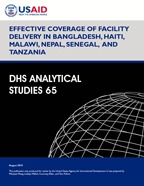- PUBLICATIONS
- JOURNAL ARTICLES
- ORDER PUBLICATIONS
Publications Summary
- Document Type
- Analytical Studies
- Publication Topic(s)
- Geographic Information, Maternal Health
- Country(s)
- Malawi, Senegal, Tanzania, Bangladesh, Nepal, Haiti
- Language
- English
- Recommended Citation
- Wang, Wenjuan, Lindsay Mallick, Courtney Allen, and Tom Pullum. 2018. Effective Coverage of Facility Delivery in Bangladesh, Haiti, Malawi, Nepal, Senegal, and Tanzania. DHS Analytical Studies No. 65. Rockville, Maryland, USA: ICF.
- Download Citation
- RIS format / Text format / Endnote format
- Publication Date
- August 2018
- Publication ID
- AS65
Download
 Effective Coverage of Facility Delivery in Bangladesh, Haiti, Malawi, Nepal, Senegal, and Tanzania (PDF, 1833K)
Effective Coverage of Facility Delivery in Bangladesh, Haiti, Malawi, Nepal, Senegal, and Tanzania (PDF, 1833K)
